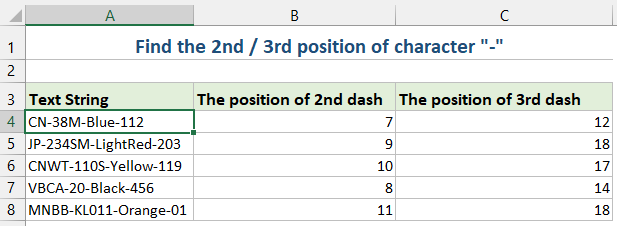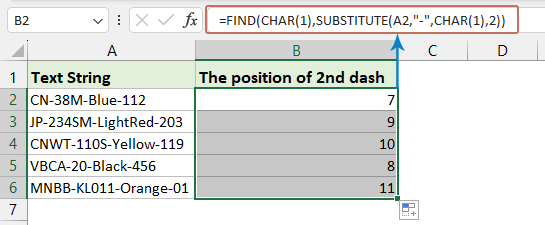Darganfyddwch yr nfed digwyddiad o gymeriad yn Excel - 3 ffordd gyflym
Gall dod o hyd i’r nfed digwyddiad o nod penodol o fewn llinyn testun yn Excel fod yn arbennig o ddefnyddiol wrth ddadansoddi data, lle gallai fod angen i chi ddosrannu llinynnau neu echdynnu gwybodaeth yn seiliedig ar amffinyddion neu batrymau penodol. Er enghraifft, gadewch i ni ddarganfod 2il neu 3ydd digwyddiad y nod "-" mewn llinyn testun. Byddaf yn dangos technegau syml i gyflawni'r dasg hon yn effeithlon.

Darganfyddwch nfed digwyddiad nod mewn llinyn testun gyda fformiwla
Gallwch chi lunio fformiwla i ddod o hyd i'r nfed digwyddiad o gymeriad. Gwnewch fel hyn os gwelwch yn dda:
1. Rhowch neu gopïwch y fformiwla ganlynol i mewn i gell lle rydych chi am gael y canlyniad:
=FIND(CHAR(1),SUBSTITUTE(A2,"-",CHAR(1),2))- A2: Y gell sy'n cynnwys y llinyn.
- -: Y cymeriad rydych chi'n chwilio amdano.
- 2: Yr 2il ddigwyddiad rydych chi am ei ddarganfod, gallwch chi ei newid i 3,4 ... yn ôl yr angen.
2. Yna, llusgwch y llenwi fformiwla i lenwi'r fformiwla i gelloedd eraill, ac 2il safle'r nod - yn cael eu harddangos ar unwaith, gweler y sgrinlun:
- TANYSGRIFIAD yn disodli nfed digwyddiad y nod gyda nod na ellir ei argraffu (CHAR(1)).
- DERBYN yn chwilio am y nod anargraffadwy hwn, gan roi safle'r nfed digwyddiad.
Darganfyddwch nfed digwyddiad o gymeriad mewn llinyn testun gyda Kutools ar gyfer Excel
Os nad ydych chi'n ffan o ddefnyddio fformiwla neu VBA, efallai y byddwch chi'n ystyried dewis arall cyfleus - Kutools ar gyfer Excel. O fewn ei grwpiau Fformiwla, fe welwch gyfleustodau defnyddiol - Darganfyddwch ble mae'r cymeriad yn ymddangos Nth mewn llinyn sy'n nodi ac yn dychwelyd nfed safle unrhyw gymeriad mewn cell yn gyflym.
Ar ôl gosod Kutools ar gyfer Excel, Cliciwch Kutools > Cynorthwyydd Fformiwla > Cynorthwyydd Fformiwla i agor y Cynorthwyydd Fformiwla blwch deialog. Cliciwch ar gell lle rydych chi am roi'r canlyniad. Yna, gwnewch fel a ganlyn:
- dewiswch Am-edrych o'r rhestr ddisgynnol o Math o Fformiwla adran;
- Dewiswch Darganfyddwch ble mae'r cymeriad yn ymddangos Nth mewn llinyn in Dewiswch fformiwla adran;
- Dewiswch y gell sy'n cynnwys y llinyn a ddefnyddiwch, yna teipiwch y nod penodedig a'r nfed digwyddiad i'r blychau testun yn y Mewnbwn dadleuon adran;
- O'r diwedd, cliciwch OK botwm i gael y canlyniad.

Darganfyddwch yr nfed digwyddiad o nod mewn llinyn testun gyda Swyddogaeth Diffiniedig Defnyddiwr
Yn yr adran hon, byddwn yn archwilio sut i greu a defnyddio UDF i ddod o hyd i'r nfed digwyddiad o gymeriad yn Excel, gan ddarparu canllaw cam wrth gam i'ch helpu i optimeiddio eich trin data.
- Dal i lawr y ALT + F11 allweddi, ac mae'n agor y Microsoft Visual Basic ar gyfer Ceisiadau ffenestr.
- Cliciwch Mewnosod > Modiwlau, a gludwch y macro canlynol yn y Ffenestr Modiwl.
Function FindN(sFindWhat As String, _ sInputString As String, N As Integer) As Integer 'Updateby Extendoffice Dim J As Integer Application.Volatile FindN = 0 For J = 1 To N FindN = InStr(FindN + 1, sInputString, sFindWhat) If FindN = 0 Then Exit For Next End Function - Yna, caewch y ffenestr vba. Ewch yn ôl i'r daflen waith, rhowch y fformiwla ganlynol i mewn i gell, ac yna llusgwch y ddolen llenwi i lawr i lenwi'r fformiwla i gelloedd eraill, gweler y sgrinlun:
=FindN("-",A2,3)
- Cyfrwch nifer y digwyddiadau o air mewn colofn
- Os oes gennych ddata colofn sy'n cynnwys rhai gwerthoedd dyblyg fel y dangosir isod, a nawr yr hyn yr ydych am ei wneud yw cyfrif nifer yr achosion o air penodol yn y golofn hon. Nawr gyda'r tiwtorial hwn, rwy'n cyflwyno rhai triciau i'w ddatrys yn gyflym yn Excel.
- Amnewid n cymeriad cyntaf neu nfed digwyddiad o gymeriad ag un arall
- Yn Excel, rydym fel arfer yn dod o hyd i ac yn disodli llinyn gan y swyddogaeth Dod o Hyd ac Amnewid, ond os ydych chi mewn un o'r achosion isod, ni all y swyddogaeth Darganfod ac Amnewid eich helpu chi.
- Echdynnu nfed nod o linyn
- Yn gyffredinol, efallai y byddwch am dynnu llinyn ar ôl cymeriad penodol, ond yn yr achos hwn, rwyf am dynnu'r nfed cymeriad o linyn fel y dangosir y sgrin isod.
- Tynnu'r n nod cyntaf/olaf o'r llinyn
- Er enghraifft, mae rhestr gyda llinynnau hir ym mhob cell, ac rydych chi am echdynnu'r n nodau cyntaf o bob llinyn yn unig, fel 3 nod cyntaf pob llinyn, a nawr gallwch chi ddefnyddio'r dulliau canlynol i'w datrys yn Excel .
Erthyglau cysylltiedig:
Offer Cynhyrchiant Swyddfa Gorau
Supercharge Eich Sgiliau Excel gyda Kutools ar gyfer Excel, a Phrofiad Effeithlonrwydd Fel Erioed Erioed. Kutools ar gyfer Excel Yn Cynnig Dros 300 o Nodweddion Uwch i Hybu Cynhyrchiant ac Arbed Amser. Cliciwch Yma i Gael Y Nodwedd Sydd Ei Angen Y Mwyaf...

Mae Office Tab yn dod â rhyngwyneb Tabbed i Office, ac yn Gwneud Eich Gwaith yn Haws o lawer
- Galluogi golygu a darllen tabbed yn Word, Excel, PowerPoint, Cyhoeddwr, Mynediad, Visio a Phrosiect.
- Agor a chreu dogfennau lluosog mewn tabiau newydd o'r un ffenestr, yn hytrach nag mewn ffenestri newydd.
- Yn cynyddu eich cynhyrchiant 50%, ac yn lleihau cannoedd o gliciau llygoden i chi bob dydd!
